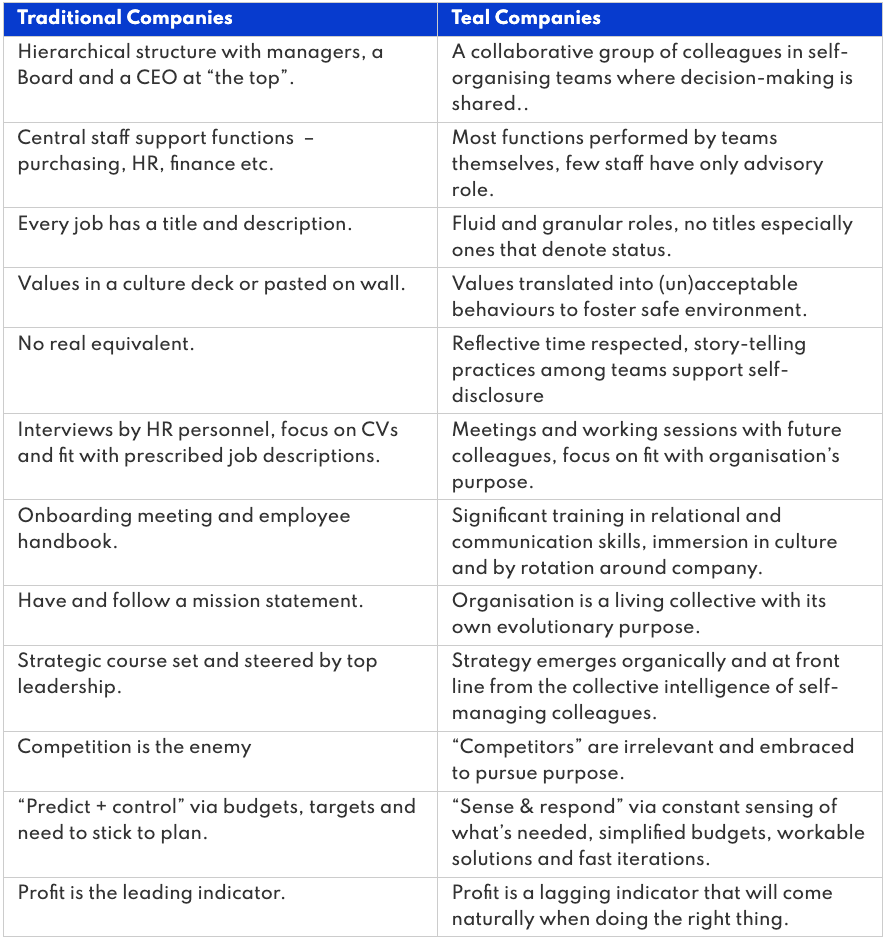Teal Companies
A new paradigm of work culture is emerging and it's set to shake up the world of work as we know it.
Author
Philippa Richardson
Pip is Founder of The Circle Line, a Transactional Analysis psychotherapist, a former City litigator and a Head of Marketing in the property industry. She works with individuals, leaders and groups to help them function well in life and work, believing that we can all write our own life story.

Tech companies get it, startups are adopting it, a rare few long-standing corporates have been successfully operating this way for decades... Teal is a way of working that has the potential to shakeup the world of work in such a dramatically positive way we may wonder how this breakthrough didn't come earlier.
The Teal Approach
A philosophy
What if we let people be people, not employees? What if colleagues worked as equals instead of in a hierarchy? What if every colleague could exercise their own sense of purpose?
A structure
What if a select few no longer make all the decisions? What if all colleagues held power? What if the CEO could no longer veto decisions? What if there was no CEO?
Back in 2014, Frederic Laloux, a former Associate Partner with McKinsey & Company and MBA graduate from INSEAD published the now-cult book, Reinventing Organizations. For three years he researched the ways in which twelve extraordinarily successful organisations operate. Laloux found that what these organisations all have in common was that they share a set of rare and unusual management practices and principles. In particular, they practised…
Self-organising
Wholeness
Evolutionary purpose
These organisations operate largely without organisation charts, management hierarchies, quarterly goals or other traditional management strategies. These instead are replaced by:
Self-organisation – Distributed authority and collective intelligence instead of rigid hierarchical management structures – natural hierarchies emerge and dissipate depending on situational context.
Wholeness – Individuals are allowed to “drop the mask,” and express all of who they are at work as and when they want to, not just those characteristics traditionally deemed to be professional.
Evolutionary purpose – The organisation has a purpose of its own. Instead of attempting to predict and control the direction of the organisation, members strive to listen and understand where the organisation collectively is naturally drawn to go.
This approach is so new and dynamic, the conversation around what Teal practices are and how to implement them continues to evolve. But they share features like self-managed teams, intuitive reasoning and decentralised decision-making (Workology).
Looking back on the historic changes of organisations and their structures and cultures across time shows us just how far we’ve evolved so far (and where at The Circle Line we hope to play a part in the journey to Teal).
Teal: The Fifth Stage of History
In Reinventing Organizations: An Illustrated Invitation to Join the Conversation on Next-Stage Organizations, Laloux describes humanity as evolving in sudden leaps, or steps. Drawing from the philosopher Ken Wilber’s colour-based description of these steps, Laloux describes five stages of human consciousness, and suggests that organisations evolve according to these same stages.
The way organisations has evolved through history goes a little like this (Strategy + Business) – an evolution that also broadly reflects the individual human lifespan from an infant with instinctive needs responding to survival-level threat, to a mature autonomous adult:
Red (impulsive) – Establishing and enforcing authority through power of chief. Examples of red organisations: Mafia, street gangs. Breakthroughs – Division of labor, top-down authority.
Amber (conformist) – Views of what is right are internalised according to a belief common to the group. Top-down command + control and self-discipline are exercised to adhere to these views. Future is repetition of past. Examples of amber organisations: Police, Army, state schools, Catholic church. Breakthroughs – Replicable processes, stable scaleable organisation chart.
Orange (achievement) – Organisations are seen as machines: predictable, and able to be scientifically understood and controlled to achieve a desired outcome. Growth and profit is the goal. Command + control over what; freedom over how. Examples of orange organisations: Wall Street banks, global corporates, most manufacturers, many MBA programs. Breakthroughs – Innovation, accountability, meritocracy.
Green (pluralistic) – Focus on culture and empowerment to boost motivation. Stakeholders replace shareholders in giving purpose. Examples of green organisations: Southwest Airlines, Zappos, Ben & Jerry’s, many nonprofits. Breakthroughs – Empowerment, values-driven culture, stakeholder value.
Teal (evolutionary) – Self-organisations replaces hierarchy in an organic and evolving system where everyone is called by an inner voice to contribute based on their unique and full potential. Examples of Teal organisations: Patagonia, Holacracy. Breakthroughs – Self-management, wholeness, evolutionary purpose.
As organisations slowly make the shift into a Teal way of operating, whether with formal constitutions like that offered by HolacracyOne, or other non-hierarchical methodologies, we wait and see what levels of success they achieve in furthering their evolving purpose. Unless, of course, we’re brave enough to join the movement and see for ourselves…
FAQs
What is a Teal organisation?
Teal organisations use an uncommon set of management practices and principles.
They are characterised by self-management, wholeness, and a deeper sense of purpose.
Teal: How do I achieve it?
There are a rare few Teal consultancies out there such as HolacracyOne and Nestr.
We hope you start by speaking to us at The Circle Line. We might not have all the answers, but we’ll certainly have a great conversation to help start you off in the right direction.
Will going Teal make my company more successful?
In-depth research has shown that it can.
All twelve of the Teal organisations LaLoux studied are extraordinarily successful.
As the Barrett Culture centre says: “Values-driven organisations are the most successful organisations on the planet.” The Barret Culture Survey backs this up: values and behaviours drive culture, culture drives employee fulfilment, employee fulfilment drives customer satisfaction, and customer satisfaction drives shareholder value.
Teal takes this established wisdom to the next level.
How long will it take to go Teal?
Hard to say. It won’t be quick – human change rarely is. Maybe 6 months to put in place the core structure and practices; probably more like 2-4 years for the essence and approach to be deeply embedded.
What's the difference between Teal and "normal" companies?
The simple answer is – their whole philosophy.
Here are some of the key differences between the two:
